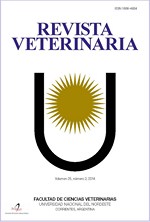Detección de pacientes COVID-19 en muestras de sudor por medio del olfato canino: Estudio preliminar
DOI:
https://doi.org/10.30972/vet.3416604Palabras clave:
COVID-19, componentes orgánicos volátiles, olfato caninoResumen
Los componentes orgánicos volátiles generados por cambios en el metabolismo de un individuo han sido utilizados para el diagnóstico de enfermedades a través del olfato canino. Hay evidencias sobre la generación de dichos componentes en la infección por SARS-COV-2. El objetivo del trabajo fue determinar la capacidad canina para discriminar a pacientes positivos y negativos a COVID-19 a través de muestras de sudor axilar. Se utilizaron muestras de sudor axilar de 102 pacientes hospitalizados tanto COVID-19 positivos (31) como negativos (71), todos diagnosticados mediante la prueba de RT-PCR. Por cada ronda de detección se colocó una única muestra positiva y el resto de las muestras (sean 1, 2, 3, 4 o 5) negativas. La sensibilidad y especificidad global fue de 93,11% (± 3,14%) y 88,52% (± 4,64%) respectivamente. La alta sensibilidad pudo deberse al entrenamiento más prolongado aumentando así, la exactitud en la detección de muestras positivas. La especificidad fue menor a otra publicada pudiéndose deber a que las muestras negativas provenían de personas internadas por otras patologías o eran acompañantes de familiares internados por lo que todas poseían olor hospitalario. La detección de pacientes COVID-19 mediante el olfato canino ha demostrado ser una prueba tamiz confiable y prometedora.Descargas
Descargas
Publicado
Cómo citar
Número
Sección
Licencia
Política de acceso abierto
Esta revista proporciona un acceso abierto inmediato a su contenido, basado en el principio de que ofrecer al público un acceso libre a las investigaciones ayuda a un mayor intercambio global de conocimiento. La publicación por parte de terceros será autorizada por Revista Veterinaria toda vez que se la reconozca debidamente y en forma explícita como lugar de publicación del original.
Esta obra está bajo una licencia de Creative Commons Reconocimiento-NoComercial 4.0 Internacional (CC BY-NC 4.0)










.jpg)
.jpg)



